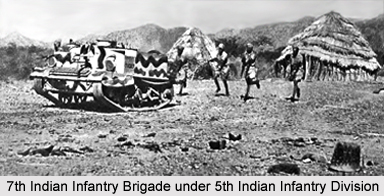 The infantry formation of the 17th Indian Infantry Brigade of the British Indian Army was raised during the outbreak of the Second World War. It remained in existence from the year 1939 till 1945. The military force was formed by the British Government of India at the Delhi Cantonment in November 1940. Initially it was assigned to the 8th Indian Infantry Division
The infantry formation of the 17th Indian Infantry Brigade of the British Indian Army was raised during the outbreak of the Second World War. It remained in existence from the year 1939 till 1945. The military force was formed by the British Government of India at the Delhi Cantonment in November 1940. Initially it was assigned to the 8th Indian Infantry Division
.
The troops took part in the Syria-Lebanon Campaign from June 1941 to July 1941 and the Anglo-Iraqi War in 1941. The 17th Indian Infantry Brigade was attached to the 10th Indian Infantry Division and functioned under its administration from July 1941 to August 1941. However, the troops were again attached with the 8th Indian Infantry Division in September 1941. They were stationed in Egypt after the culmination of the Anglo-Soviet invasion of Iran.
The British Indian infantry brigade also served as garrison force in 1942 in Syria. Afterwards, the troops provided military service in the Italian Campaign of Second World War.
Formation of 17th Indian Infantry Brigade
The 17th Indian Infantry Brigade was formed by several infantry units. These are listed below-
* 1/5th Gurkha Rifles (November 1940 - July 1941; October 1941 - August 1945)
* 1/12th Frontier Force Regiment (May 1941 - June 1945)
* 32nd Field Regiment, Royal Artillery (July 1941)
* 1st King`s Own Royal Regiment (July 1941 - December 1941)
* 1st Royal Fusiliers (December 1941 - June 1945)
* 144th Field Regiment, Royal Artillery (July 1942 - August 1942)
* 50th Royal Tank Regiment (November 1943)
* 52nd Field Regiment, Royal Artillery (November 1943)
* 166th Field Regiment, Royal Artillery (November 1943)
* 11th Canadian Armoured Regiment (April 1944 - May 1944)
* 6/13th Frontier Force Rifles (June 1944)
* 4th Anti Tank Regiment, Indian Artillery (August 1944)
* 6th Duke of Connaught`s Own Lancers (August 1944)
* 5/5th Mahratta Light Infantry (August 1944)
* 1st Jaipur Infantry (December 1944 - April 1945)



















